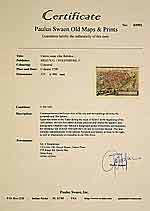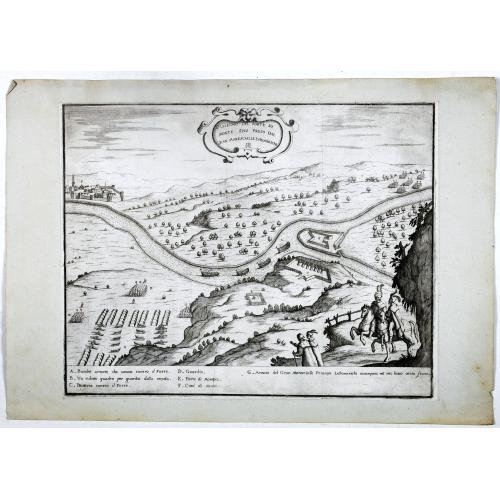Lot #: 38430
DISSEGNO DEL FORTE DI MONTE SPIZ PRESO DAL GRAN MARESCIALLE LUBOMIRSCHI. |
||||||||||||||||||||
|
||||||||||||||||||||
|
|
||||||||||||||||||||
|
Selling price: $550
Sold in 2016 Join our News Letter to get informed when a similar item comes available. Do you have an example you would like to sell? |
Views: 138
|
|||||||||||||||||||
Description
An etching shows the Polish military leader and nobleman Jerzy Sebastian Lubomirski (1616–1667) above the fortress Biala Góra (here marked in Italian as Monte Spiz and Monspiz) on the crossing of the Nogat and Vistula River. In the background the city Gniew, situated on the left bank of the Vistula River, in the Pomeranian Voivodeship in present-day Poland.
Prepared by Galeazzo Gualdo Priorato (1606 – 1678) and published in "Historia di Leopoldo Cesare I–III", Vienna, 1670–1674.
Johann Baptist Hacque (1634–1678), a Viennese publisher of Flemish origin, was active in the capital of the Habsburg monarchy from the beginning of the 1660s. He was one of the most prominent and influential publishers in Central Europe in the second half of the 17th century. Besides a prestigious commission for the compendium Historia di Leopoldo Cesare, he published weekly newspapers in Italian and Latin (Il Corriere Ordinario and Cursor Ordinarius).
It is understandable that for co-operation, Hacque was able to choose from among a great number of Flemish artists working in Vienna in the 1660s and 70s. After Hacques death in 1678, the publishing house was taken over by his brother-in-law, Johann van Ghelen (1645–1721), with privileges granted by the emperor.
In the same year he became the official publisher of the Vienna University. His son Johann Peter van Ghelen (1673–1754) and grandson Leopold van Ghelen (1708–1760) further developed the family business into the most important and privileged publishing house in Central Europe.
The work on this extensive book by Galeazzo Gualdo Priorato (1606–1678), describing the political and military successes of Emperor Leopold I between 1656 and 1670, combined the efforts of a whole generation of Flemish artists trying to get ahead in the capital city of the monarchy. However, there were not only Flemish artists (painters and engravers) co-operating on the celebrative book, there were also artists from Germany and Italy. The first and the second volumes were published in 1670.
The third volume was published in 1674. They mainly contain portraits of European monarchs and important aristocrats, castle scenes, battle scenes, maps and ceremonies. The authors of the majority of the engravings and their models were Dutch artists Cornelis Meyssens, Frans van der Steen, Jacob Toorenvliet, Gerard Bouttats, Adriaen van Bloemen, Jan de Herdt, Frans Geffels, Sebastian van Dryweghen, German artists Moritz Lang, Johann Martin Lerch and Johann Holst, and Italians Il Bianchi, Marco Boschini and Leonardus Hen.t Venetiis.
The matrices for the graphic accompaniments to Historia di Leopoldo Cesare were also printed in other publications and distributed in the form of free sheets. Only the context in which the sheets were presented changed as well as the details of the margin decoration and legends (registers).
In the Czech environment, almost identical pages emerged in the book by a Prague lawyer writing in German and a syndic of the Lesser Town of Prague, Johann Jakob Weingarten, Fürsten Spiegel oder Monarchia deß Höchlöblichen Ertz-Hauses Oesterreich, published in Prague in 1673. (text by Miroslav Kindl )
Prepared by Galeazzo Gualdo Priorato (1606 – 1678) and published in "Historia di Leopoldo Cesare I–III", Vienna, 1670–1674.
Johann Baptist Hacque (1634–1678), a Viennese publisher of Flemish origin, was active in the capital of the Habsburg monarchy from the beginning of the 1660s. He was one of the most prominent and influential publishers in Central Europe in the second half of the 17th century. Besides a prestigious commission for the compendium Historia di Leopoldo Cesare, he published weekly newspapers in Italian and Latin (Il Corriere Ordinario and Cursor Ordinarius).
It is understandable that for co-operation, Hacque was able to choose from among a great number of Flemish artists working in Vienna in the 1660s and 70s. After Hacques death in 1678, the publishing house was taken over by his brother-in-law, Johann van Ghelen (1645–1721), with privileges granted by the emperor.
In the same year he became the official publisher of the Vienna University. His son Johann Peter van Ghelen (1673–1754) and grandson Leopold van Ghelen (1708–1760) further developed the family business into the most important and privileged publishing house in Central Europe.
The work on this extensive book by Galeazzo Gualdo Priorato (1606–1678), describing the political and military successes of Emperor Leopold I between 1656 and 1670, combined the efforts of a whole generation of Flemish artists trying to get ahead in the capital city of the monarchy. However, there were not only Flemish artists (painters and engravers) co-operating on the celebrative book, there were also artists from Germany and Italy. The first and the second volumes were published in 1670.
The third volume was published in 1674. They mainly contain portraits of European monarchs and important aristocrats, castle scenes, battle scenes, maps and ceremonies. The authors of the majority of the engravings and their models were Dutch artists Cornelis Meyssens, Frans van der Steen, Jacob Toorenvliet, Gerard Bouttats, Adriaen van Bloemen, Jan de Herdt, Frans Geffels, Sebastian van Dryweghen, German artists Moritz Lang, Johann Martin Lerch and Johann Holst, and Italians Il Bianchi, Marco Boschini and Leonardus Hen.t Venetiis.
The matrices for the graphic accompaniments to Historia di Leopoldo Cesare were also printed in other publications and distributed in the form of free sheets. Only the context in which the sheets were presented changed as well as the details of the margin decoration and legends (registers).
In the Czech environment, almost identical pages emerged in the book by a Prague lawyer writing in German and a syndic of the Lesser Town of Prague, Johann Jakob Weingarten, Fürsten Spiegel oder Monarchia deß Höchlöblichen Ertz-Hauses Oesterreich, published in Prague in 1673. (text by Miroslav Kindl )
FAQ - Guarantee - Shipping
In our BUY-or-BID sale, you never pay more than the Buy price.
To buy or bid in this Buy-or-Bid sale you must register with us. It is free, and we automatically update you about future auctions.During the Buy-or-Bid sale, you can buy or bid on 600- 900 antique, rare maps, town views, old master prints, decorative prints, atlases, posters and Medieval manuscripts.
- We show the "Bid & Ask spread" (to define the gap between the minimum accepted bid and Buy price.)
- Items that have received bids within the BidAsk spread are sold at the highest bid at closing.
- Once the Buy price is paid, the sale for this item has closed.
Do you have a similar item you want to sell ?
Interested in selling your antique maps, original prints, vintage posters, or historic Ephemera?Let us help you!
Start your consignment today. We provide estimates free of charge from photographs sent via the Internet. Fill out our online estimation form, and we will contact you with an estimate.
Learn more about consigning at RarePaperSales.com
Guarantee
 We warranty the authenticity of each lot offered in our sale. There is no time limitation to this guarantee.
We warranty the authenticity of each lot offered in our sale. There is no time limitation to this guarantee.- Defects in lots have been carefully noted.
- If there are no remarks regarding splits, tears, discoloration, etc., there are no issues to be found for the item!
- All items are carefully and personally examined before being packed "in-house" and shipped by UPS, USPS, DHL or registered mail.
- We do not sell reproductions.
- A certificate of authenticity is provided for each acquired item and can be downloaded from your invoice page.
- Certificates can be found in the Invoice and Certificates center.
Shipping
Maps are shipped in solid tubes or flat between solid cardboard. Fully insured, signature required, and with online tracking. Shortly after shipment, you will get the tracking number by email.The standard is that we ship items by UPS or DHL for European destinations, and a flat shipping fee is added to each shipment. It is a one-time fee even if you buy multiple items. This fee covers shipping and insurance (up to the invoice amount) to:
- North America, Canada, Europe $ 30
- Asia $ 40
- For South America, Mauritius, Africa and Australia a shipping fee of $ 50 will be charged.
We charge only a one-time shipping fee if you have won 2 or more items.

Hold Shipment Service
Rare Paper Sales allows you to put your shipping on hold at no additional charge. This can be incredibly convenient for people who want to buy several items at different auctions and ship them together. The service is free, and you pay only one shipment fee.
Contact us if you want to use the Hold Service.
High-Resolution Digital Image Download |
|
|
RarePaperSales maintains an archive of most of our high-resolution rare maps, prints, posters and medieval manuscript scans. We make them freely available for download and study. Read more about free image download |
